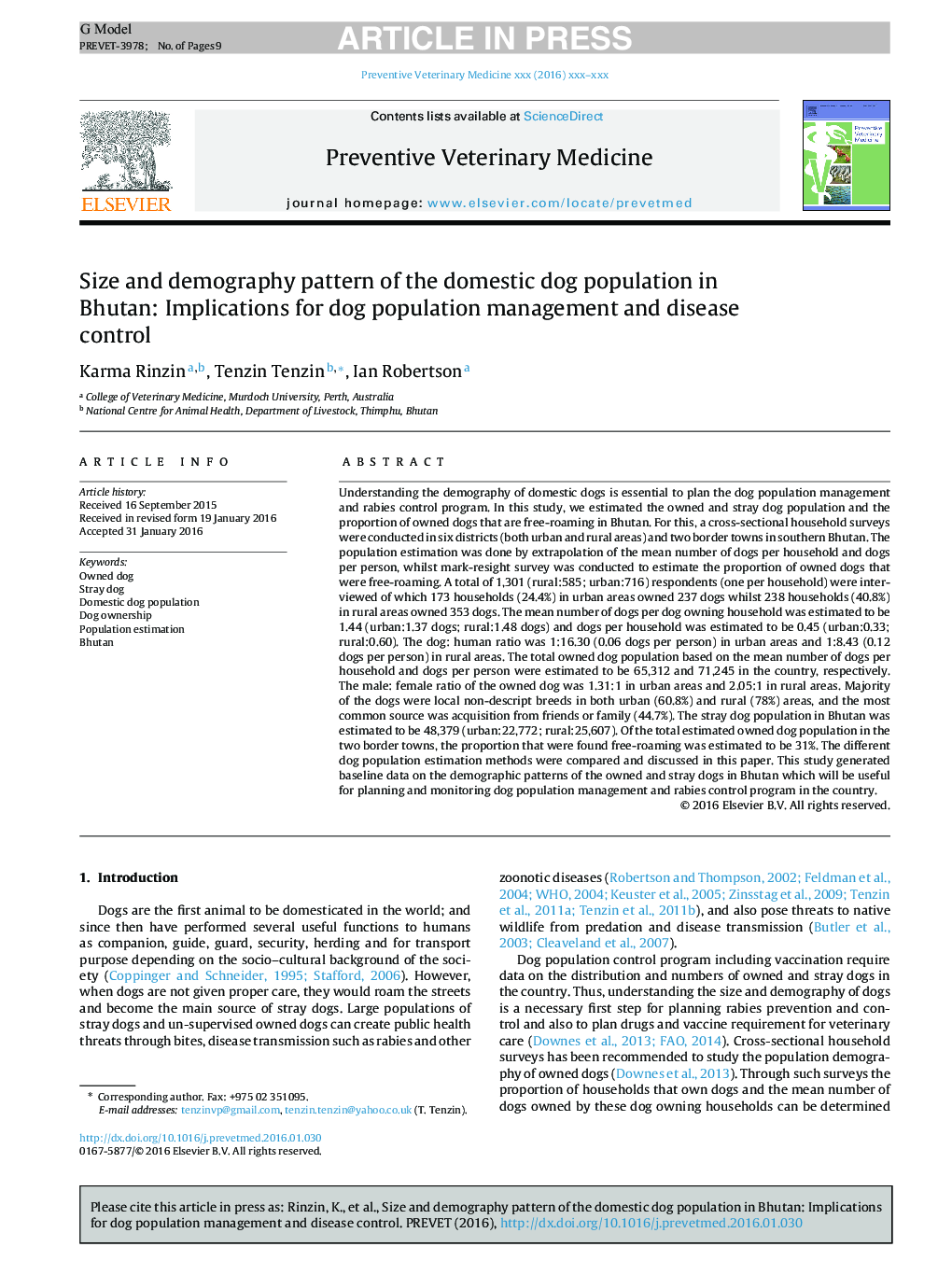| کد مقاله | کد نشریه | سال انتشار | مقاله انگلیسی | نسخه تمام متن |
|---|---|---|---|---|
| 5792951 | 1554162 | 2016 | 9 صفحه PDF | دانلود رایگان |
عنوان انگلیسی مقاله ISI
Size and demography pattern of the domestic dog population in Bhutan: Implications for dog population management and disease control
ترجمه فارسی عنوان
الگوی اندازه و جمعیت سگ داخلی در بوتان: پیامدهای مدیریت جمعیت سگ و کنترل بیماری
دانلود مقاله + سفارش ترجمه
دانلود مقاله ISI انگلیسی
رایگان برای ایرانیان
کلمات کلیدی
سگ متعلق به، سگ های ولگرد، جمعیت سگ داخلی، مالکیت سگ، برآورد جمعیت، بوتان،
ترجمه چکیده
درک جمعیت شناسی سگ های خانگی برای برنامه ریزی کنترل جمعیت سگ و برنامه کنترل هاری است. در این مطالعه، جمعیت سگهای متعلق به سگ و ولگرد و نسبت سگهای متعلق به رومینگ رایگان در بوتان را برآورد کردیم. برای این منظور، یک بررسی متقاطع خانوار در شش ولسوالی (هر دو مناطق شهری و روستایی) و دو شهر مرزی در جنوب بوتان انجام شد. برآورد جمعیت با استفاده از استخراج میانگین تعداد سگ ها در هر خانوار و سگ در هر فرد انجام شد، در حالیکه ارزیابی علامت-امتیاز برای ارزیابی نسبت سگ های متعلق به رومینگ رایگان انجام شد. مجموعا 1301 نفر (585 روستا و 716 شهری) 716 نفر مصاحبه شدند که 173 خانوار (24.4 درصد) در مناطق شهری دارای 237 سگ بودند و 238 خانوار (40.8 درصد) در مناطق روستایی 353 سگ داشتند. میانگین تعداد سگ ها در هر سگ خانوار متعلق به 1.44 (شهر: 1.37 سگ، روستا: 1.48 سگ) و سگ در هر خانوار 0.45 (شهری: 0.33، روستا: 0.60) تخمین زده شد. نسبت سگ: 1: 16.30 (0.06 سگ به ازای هر نفر) در مناطق شهری و 1: 43.84 (سنی 0.12 سگ در هر نفر) در مناطق روستایی. مجموع جمع آوری سگ متعلق به بر اساس میانگین تعداد سگ ها در هر خانوار و سگ در هر نفر به ترتیب 65،312 و 71،245 در بر داشت. نسبت زن و مرد نسبت به سگ متعلق به 1.31: 1 در مناطق شهری و 2.05: 1 در مناطق روستایی بود. اکثریت این سگ ها در مناطق شهری (8/60٪) و روستایی (78٪) نژادهای غیرقابل توصیف محلی بودند و شایع ترین منبع از دستیابی به دوستان یا خانواده (7/44٪) بود. جمعیت سگ ولگرد در بوتان 48،379 (شهر: 22،772، روستا: 25،607) تخمین زده شد. از مجموع جمعیت تخمین زده شده سگ در دو شهر مرزی، نسبتی که به صورت رایگان آزاد در نظر گرفته شد 31٪ بود. روش های مختلف تخمینی جمعیت سگ در این مقاله مورد مقایسه و بررسی قرار گرفت. این مطالعه داده های پایه ای را درباره الگوهای جمعیت شناسی سگ های متعلق به ولگرد و بوتان در بوتان ارائه می دهد که برای برنامه ریزی و کنترل برنامه های کنترل جمعیت سگ و برنامه کنترل هاری در کشور مفید خواهد بود.
موضوعات مرتبط
علوم زیستی و بیوفناوری
علوم کشاورزی و بیولوژیک
علوم دامی و جانورشناسی
چکیده انگلیسی
Understanding the demography of domestic dogs is essential to plan the dog population management and rabies control program. In this study, we estimated the owned and stray dog population and the proportion of owned dogs that are free-roaming in Bhutan. For this, a cross-sectional household surveys were conducted in six districts (both urban and rural areas) and two border towns in southern Bhutan. The population estimation was done by extrapolation of the mean number of dogs per household and dogs per person, whilst mark-resight survey was conducted to estimate the proportion of owned dogs that were free-roaming. A total of 1,301 (rural:585; urban:716) respondents (one per household) were interviewed of which 173 households (24.4%) in urban areas owned 237 dogs whilst 238 households (40.8%) in rural areas owned 353 dogs. The mean number of dogs per dog owning household was estimated to be 1.44 (urban:1.37 dogs; rural:1.48 dogs) and dogs per household was estimated to be 0.45 (urban:0.33; rural:0.60). The dog: human ratio was 1:16.30 (0.06 dogs per person) in urban areas and 1:8.43 (0.12 dogs per person) in rural areas. The total owned dog population based on the mean number of dogs per household and dogs per person were estimated to be 65,312 and 71,245 in the country, respectively. The male: female ratio of the owned dog was 1.31:1 in urban areas and 2.05:1 in rural areas. Majority of the dogs were local non-descript breeds in both urban (60.8%) and rural (78%) areas, and the most common source was acquisition from friends or family (44.7%). The stray dog population in Bhutan was estimated to be 48,379 (urban:22,772; rural:25,607). Of the total estimated owned dog population in the two border towns, the proportion that were found free-roaming was estimated to be 31%. The different dog population estimation methods were compared and discussed in this paper. This study generated baseline data on the demographic patterns of the owned and stray dogs in Bhutan which will be useful for planning and monitoring dog population management and rabies control program in the country.
ناشر
Database: Elsevier - ScienceDirect (ساینس دایرکت)
Journal: Preventive Veterinary Medicine - Volume 126, 1 April 2016, Pages 39-47
Journal: Preventive Veterinary Medicine - Volume 126, 1 April 2016, Pages 39-47
نویسندگان
Karma Rinzin, Tenzin Tenzin, Ian Robertson,
